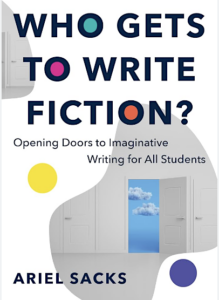Engaging All Students with Imaginative Writing
Who Gets to Write Fiction: Opening Doors to Imaginative Writing for All Students
By Ariel Sacks
(Norton, 2023 – Learn more)
Reviewed by Stacy Haynes-Moore

Steven turns toward his classmate, Alex. The boys collaborate, laptops in hands, and they write, write, write. “We are teaming them up so they survive. They’re the winners.” The two couldn’t get enough of the fan fiction scenes they were writing to coincide with a class reading of The Hunger Games.
Prior to this school year, the boys’ experiences in most of their ELA classrooms included a heavy focus on reading books and writing essays. Their literature teacher for this year, Ms. Knowles, introduced lessons that asked students to imagine original characters and write new scenes for the novel as a response to reading. Ms. Knowles’s rationale: Why not? The writings motivate and energize students as learners.

Teacher-author Ariel Sacks reassures her readers that choosing to embed imaginative writing in the mapped scope and sequence can be a powerful decision. “The ability to write fiction and other imaginative forms in English Language Arts opens many doors for young people. All of them are critical to the development of our students, our education system, and our democracy” (p. 3).
She positions imaginative writing as an essential component within school studies; for this key reason, I added the book to my summer stack, which proved to be a smart choice. I recommend that readers be prepared with a stack of Post-its for annotations, as you’re likely to note and notice your way through the chapters and want the references as a run-up toward planning during fall semester.
The book, at 218 pages, includes plenty of insights about the art of teaching. Hone in with the following passages and allow time to reflect. Consider how the presented materials and lesson ideas can be intentionally fitted within your existing work with ELA students:
►Eight doors we open for students when we include imaginative writing (p. 3)
This section provides us with rationale. Why should we make space for creative writing? How might it help students as learners in the short and long-term? Sacks points to motivation, balance of classroom power, and students’ mastery of literary elements as some of the doors opened when students write creatively. Sacks will return to these ‘eight doors’ throughout the book to frame imaginative writing as transformative.
►How it comes together: Four months of curriculum with four integrated roles (p. 46)
A practical appeal of this book is the detail Sacks provides in describing her approaches to teaching literature and organizing students for response. In this section Sacks illustrates how she groups students by roles in order to discuss and study class readings – folk tales, classics, memoirs, etc. Details of the assignments help the teacher-reader understand how to partner experiences of analytical thinking and creative writing.
►Leading through difficult moments (p. 125)
It can be a proud moment when a student shares their own writing to classmates. There will be applause. There may be discussion or follow-up questions. And, there may be uncomfortable moments in which the teacher and class must offer comments that express concerns or challenge the student writer’s choices as an author. Sacks’ chapter is essential for teachers to think about public feedback to student authors and anticipating how to facilitate difficult conversations, doing so in a way that guides and supports the student writer and their classmates.
►Organizing and assessing imaginative writing instruction (p. 199)
Schools have systems and protocols we follow as teachers. As professionals, we know it is important to prepare and think about how to organize and assess. Teacher-readers might talk back to the author with questions like How do I make time for creative writing among everything else I need to cover and accomplish in ELA? How do I differentiate for my students? How should I grade and provide feedback? With calmness and care, Sacks tempers teaching anxieties by laying out specific examples for lessons, along with suggested pacing schedules.
As a whole, Who Gets to Write Fiction illustrates for teacher-readers the practicality and value of bringing creative response into our instructional approaches to English Language Arts. It’s a valuable read individually or in a study group.
Read Ariel Sacks’ MiddleWeb article:
“Add Imaginative Writing to Your ELA Classroom”
Dr. Stacy Haynes-Moore is a veteran classroom teacher for K-12 schools and has served district colleagues in various leadership roles, including that of instructional coach and curriculum facilitator for grades 6-12 English Language Arts. She currently carries forward her passion for teaching, learning, and leading as Assistant Professor in Education at Coe College.





























